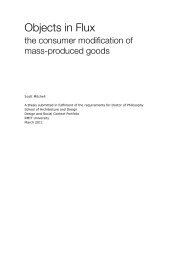Making Memory Space: Recollection and Reconciliation in Post ...
Making Memory Space: Recollection and Reconciliation in Post ...
Making Memory Space: Recollection and Reconciliation in Post ...
You also want an ePaper? Increase the reach of your titles
YUMPU automatically turns print PDFs into web optimized ePapers that Google loves.
sites of Apartheid forms the basis for Chapters Two <strong>and</strong> Four of this thesis, each suggest<strong>in</strong>g differ<strong>in</strong>g<br />
solutions for approach<strong>in</strong>g exist<strong>in</strong>g memory.<br />
The post Apartheid city<br />
The f<strong>in</strong>al, contemporary trope is that of the post Apartheid city, one that is struggl<strong>in</strong>g to reconcile the<br />
spatial divisions of the past with the ideologically-conceived notions of the all-<strong>in</strong>clusive ‘Ra<strong>in</strong>bow<br />
Nation’. The historically-constructed cityscape is attempt<strong>in</strong>g to resituate itself both nationally <strong>and</strong><br />
<strong>in</strong>ternationally, to take its place <strong>in</strong> the global l<strong>and</strong>scape of tourist dest<strong>in</strong>ations while seek<strong>in</strong>g to def<strong>in</strong>e<br />
itself as a new, multicultural place of <strong>in</strong>clusion. The difficulties <strong>in</strong>herent <strong>in</strong> redef<strong>in</strong><strong>in</strong>g built form, the<br />
questions around the production of memory <strong>and</strong> the latent significance of sites of trauma all contribute<br />
to the issues addressed here. Exam<strong>in</strong><strong>in</strong>g the specific production of differ<strong>in</strong>g modes of memory space,<br />
this thesis seeks to better underst<strong>and</strong> the role that official productions of memory space may play <strong>in</strong> a<br />
society undergo<strong>in</strong>g radical change, growth <strong>and</strong> redef<strong>in</strong>ition.<br />
In summary, it becomes clear that memorials <strong>and</strong> museums cannot be considered alone but are the<br />
result of spatial, historical, economic, social <strong>and</strong> political forces which all contribute to their production.<br />
In the same manner that memory does not exist <strong>in</strong> isolation <strong>and</strong> is prompted by a madele<strong>in</strong>e à la<br />
Marcel Proust or an image, token or visit to a site of the past, memory space <strong>and</strong> the memory it<br />
conjures up, are the products of the society <strong>and</strong> environment from whence they derive. In order to<br />
underst<strong>and</strong> memory space more fully, it is necessary to appreciate the context that led to its<br />
production. Site plays a very significant role <strong>in</strong> the creation <strong>and</strong> ma<strong>in</strong>tenance of memory space: <strong>in</strong> the<br />
form of a ‘traumascape’ which witnessed the past or the establishment of a museum as a site-<br />
symbolic repository of memory. As a result museums <strong>and</strong> memorials are becom<strong>in</strong>g <strong>in</strong>tertw<strong>in</strong>ed, so that<br />
museums beg<strong>in</strong> to operate as memorials <strong>and</strong> vice versa. <strong>Memory</strong> space becomes a visceral, emotive<br />
experience attempt<strong>in</strong>g to ground itself <strong>in</strong> the local while still appeal<strong>in</strong>g to the global. Contemporary<br />
memory practice <strong>in</strong> South Africa is seek<strong>in</strong>g to identify a new form of memory language, one that<br />
suitably reflects an African oral tradition <strong>and</strong> makes mean<strong>in</strong>gful a civic form that was traditionally<br />
alienat<strong>in</strong>g <strong>and</strong> exclusionary. It is attempt<strong>in</strong>g to acknowledge the presence of memory <strong>in</strong> daily life while<br />
simultaneously provid<strong>in</strong>g a version of the past that is palatable to a diverse audience. Furthermore, it<br />
is attempt<strong>in</strong>g to come to terms with sites of the past, both exist<strong>in</strong>g memorials <strong>and</strong> structures that<br />
facilitated Apartheid so that the city <strong>and</strong> the country may grow beyond the spatial conf<strong>in</strong>es of its<br />
Apartheid past.<br />
32
















